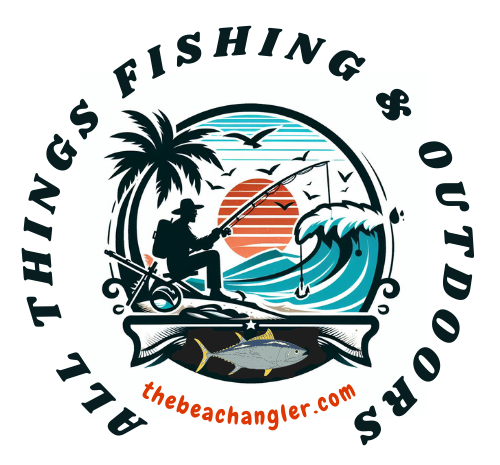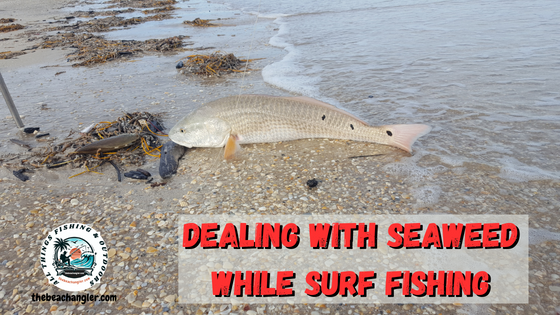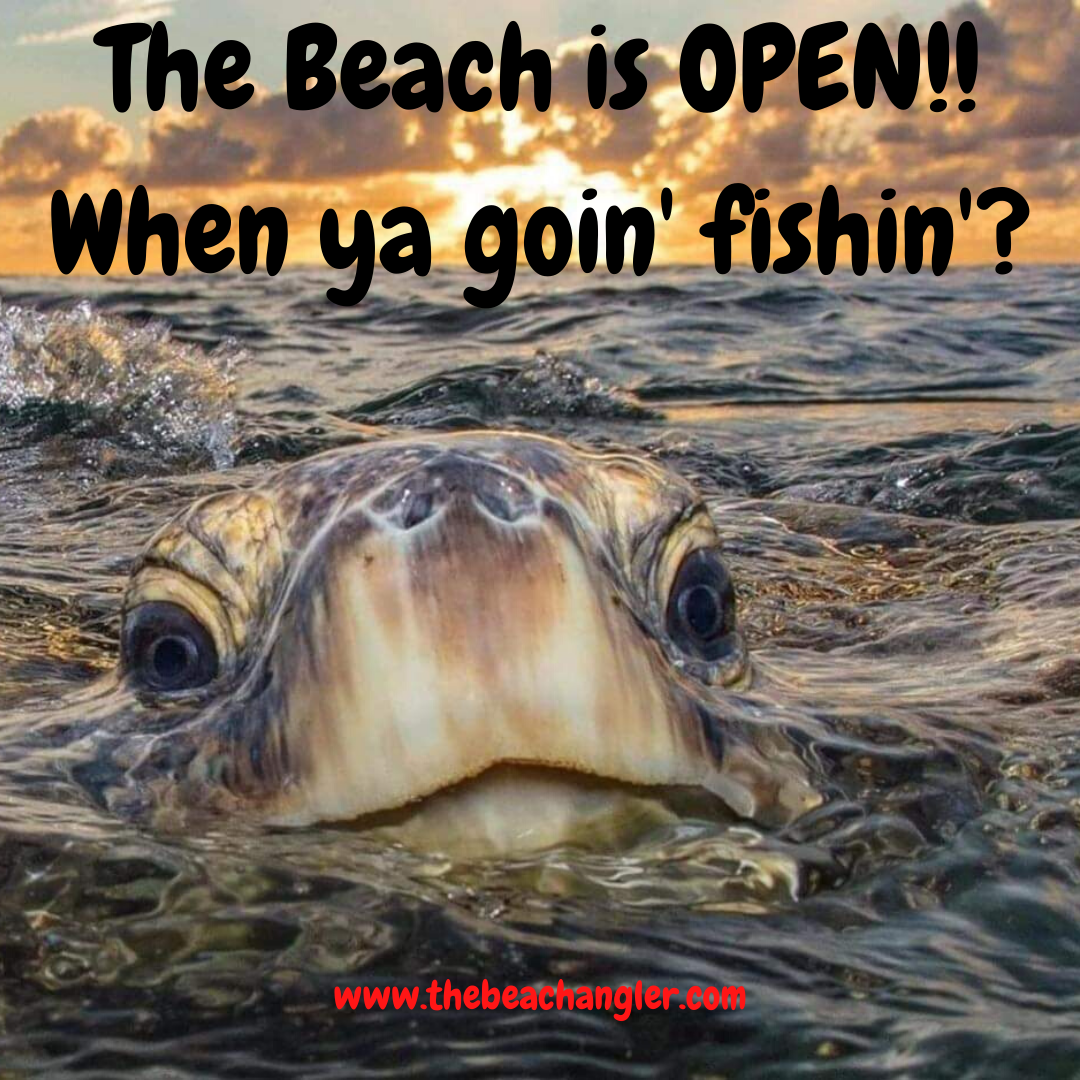If you’ve ever spent any time surf fishing, you know that seaweed is just sometimes par for the course. It’s a natural part of coastal ecosystems, but as a fisherman, seaweed can make your outing challenging, to say the least. Surf fishing in these conditions requires a certain finesse and an understanding of how aquatic vegetation impacts where and how fish feed.
QUICK LOOK: 7 Tips for Dealing With Seaweed and Vegetation While Surf Fishing:
- Use Braided Line: – opt for a braided line known for its thin diameter and exceptional strength. Often with a swift jerk of the rod braided line will slice through seaweed rather than getting stuck in it.
- Use Longer Heavier Action Rods: – Your rod and reel should complement your line choice. A longer rod gives you a casting distance advantage, which is crucial for placing your bait beyond and above thick vegetation bands.
- Use Taller and Longer Sand Spikes and Rod Holders: – If setting out baits get your rod tip as high as possible to minimize the amount of line you have floating or under the water. The more line in the water, the more seaweed, and vegetation issues.
- Use Weedless Lures and Single Hook Rigs: – Using weedless lures or switching out treble hooks for single circle hooks can reduce your seaweed problems.
- Switch to a Float or Drift Rig: – switching to a float or drift rig will allow you to walk along the beach with the current and drifting vegetation. This keeps your line in the water fishing longer before needing to clear weed.
- Set Your Baits at a 45-degree Angler Up Current: – As seaweed snags on your line with it at a 45-degree angle up current, the current will push the weed up your line toward the shore where you can easily remove it.
- Check and Clear Your Lines Often: – resign yourself to the fact that you will be checking lines and baits often to clear the weed and debris buildup.
Seaweed affects your technique; it can tangle your line, bury your hooks, and even obscure your bait from fish. Recognizing that some days the sea seems more weed than water, I adapt. It’s about adjusting tactics to work with the environment rather than against it. Some days, seaweed can be sparse or non-existent; other days, it can make fishing nearly impossible.
So why even tackle it? Because, even with the hurdles it presents, surf fishing amid the greens and browns of the ocean’s garden can be incredibly productive if you know how to do it. Fish often congregate in and around the seaweed, seeking shelter and food.
And in these situations, one thing becomes clear: the more you understand how to work with the seaweed, rather than against it, the more successful you’ll become at catching fish. I’ve seen fish feeding aggressively around giant mats of sargassum weed. Getting my lure or bait to them however was the challenge.
The Art of Dealing with Seaweed and Vegetation While Surf Fishing
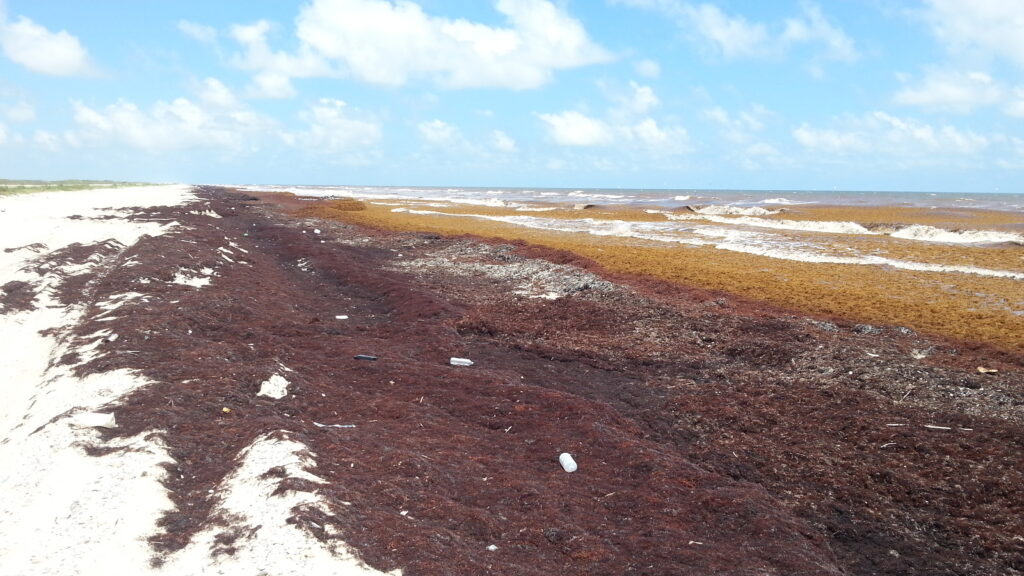
When I hit the surf with my rod and reel, I’ve learned that the thick beds of seaweed are not just obstacles; they’re just part of the game. How you manage your line through this marine forest can make or break your day.
You need to adjust your tactics to match the conditions. If you are casting with artificial lures you may need to switch to weedless lures or swap out treble hooks for single circle hooks. If you are casting baits you may need to set them at a 45-degree angle to the current so any weed accumulation will be pushed up your line toward your rod instead of down to your rig.
In particularly heavy weed concentrations using a float to keep your bait drifting along with the vegetation can be an effective tactic. Casting and drifting baits along the bottom with the current as you walk along the beach keeping your bait perpendicular to the shore works well when fish are at or near the bottom.
When you do snag some vegetation, stay patient. A quick, sharp flip of the rod tip can often throw the weed off your line. It may sound trivial, but mastering this flip has saved me countless hours and has kept my line in the water fishing where it belongs. Of course, there are times you just have to either wade out and remove the weed build up, or reel in to clear your line and gear.
Tackle and Gear for Dealing with Seaweed While Surf Fishing
When you’re facing a shoreline brimming with seaweed, you have two choices you can call it off and go home, or suck it up and adjust your tactics and gear. It’s critical to outfit yourself with tackle capable of dealing with the situation at hand. With the right gear in hand, you can salvage your fishing trip and even catch some fish. The following are some gear adjustments that will help with seaweed and vegetation.
Tackle and Gear Adjustments for Dealing with Seaweed and Vegetation.
1. Use Braided Line: A heavier line might be your first instinct to muscle through vegetation, but in practice, you’ll want to opt for a braided line known for its thin diameter and exceptional strength. Often with a swift jerk of the rod braided line will slice through seaweed rather than getting stuck in it. Additionally, a braided is much more sensitive, helping you distinguish between seaweed snags and actual fish strikes.
2. Use Longer and Heavier Action Rods: Your rod and reel should complement your line choice. A longer rod gives you a casting distance advantage, which is crucial for placing your bait beyond and above thick vegetation bands. And, once your baits are set, the longer rod will keep more of the line between you and your bait out of the water and away from the weed.
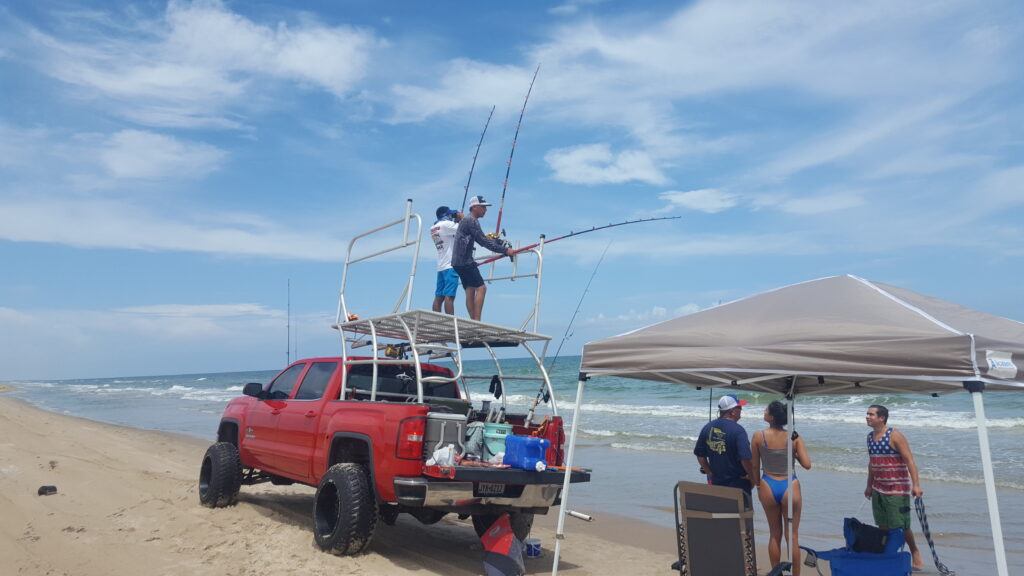
3. Use Taller Sand Spike Rod Holders: If setting out baits you want to get your rod tip as high as possible to minimize the amount of line you have floating or under the water. The more line you have in the water column, the more opportunity seaweed, vegetation, and other debris have to latch on. Elevated platforms such as those commonly used for shark fishing are very effective for dealing with seaweed.
4. Use Weedless Lures and Single Hook Rigs: Using weedless lures or switching out treble hooks for single circle hooks can reduce your seaweed problems. Single-hook bait rigs will also gather less vegetation than multi-hook rigs.
5. Switch to A Float or Drift Rig: If the vegetation or seaweed is just too dense for stationary bait set-ups then switching to a float or drift rig will allow you to walk along the beach with the current and drifting vegetation. This keeps your line in the water fishing longer before needing to clear weed.
6. Set Your Baits at a 45-degree Angle Up Current: If you are setting baits in the surf and dealing with both seaweed and current, walk up current before casting and setting your bait. Then walk back and put your rod in the sand spike. As seaweed snags on your line with it at a 45-degree angle up current, the current will push the weed up your line toward the shore where you can easily remove it instead of down your line where it accumulates on your gear.
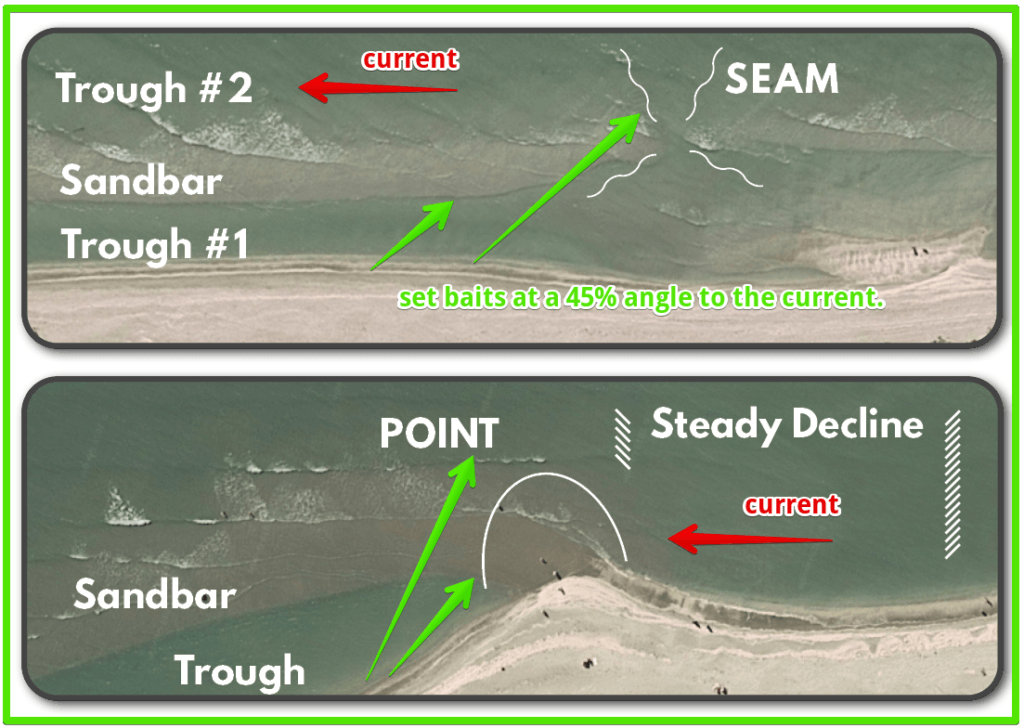
7. Check Your Lines and Baits Often: If you’re dealing with seaweed and vegetation while surf fishing you are going to resign yourself to the fact that you will be checking lines and baits often to clear the weed and debris buildup.
Timing and Location for Dealing with Seaweed
I understand the frustration of dealing with excessive seaweed when all you want is a relaxing day of surf fishing. The good news is that with the right know-how, you can still enjoy a day of surf fishing, and maybe even catching. 😉
First, consider the tides and currents: Fish typically feed in the surf better when there is water movement. Movement from either tides or currents. Moving water loaded with seaweed, vegetation or other debris can make setting baits in the surf difficult at best. Calmer less windy days with less current and wave action make dealing with seaweed easier.
Location, Location, Location: You won’t always find seaweed distributed evenly along the shore. Walk or drive the beach before setting up. Look for areas with less seaweed. Sometimes moving a mile or two down the beach can make a huge difference. While everyone else is fighting the vegetation, you could be catching fish in the clear water.
Consider the Season: Finally, don’t overlook the power of seasons and water temperatures. Seaweed growth fluctuates throughout the year. Do some research or ask local fishers when the vegetation is less problematic. Adjusting your fishing schedule according to these patterns can dramatically improve your experience.
Keep these tips in your back pocket for the next session, and shift your tactics if you find yourself amidst a marine garden. Remember, perseverance paired with strategy often leads to the best catches. And, a whole lot less frustration!
Common Challenges When Dealing with Seaweed While Surf Fishing
When you’re surf fishing, seaweed can often feel like an adversary. It is a very important part of the marine ecosystem. Many marine animals either hide in the vegetation or hunt for an easy meal in and around it.
One common frustration is managing your line among drifting seaweed or dense underwater vegetation. Here’s a scenario: you’ve cast your line perfectly, you’re waiting patiently, and then you feel its telltale tug that’s not a fish, but a clump of seaweed snagging your hook.
First of all, DON’T PANIC. Dealing with seaweed snagging is part and parcel of the surf fishing experience. Reel in your line, clear the weed, and cast out again. Patience and persistence are key to dealing with drifting vegetation and debris.
If you hook a fish and find yourself battling seaweed at the same time. Priority one is to maintain control of your line and drag to give you the best chance at landing the fish. Keep your line tight and your rod tip up. If the seaweed is too much for your rod, don’t be afraid to retrieve your line manually with your hand (just be careful of line burns).
Now accidents do happen, and on occasion, your line can break or your sinker get buried in a mat of seaweed. It happens to all of us eventually. No worries, just tie on another rig or lure, and try again. Remember, surf fishing, even when dealing with seaweed, is better than working or sitting at home watching TV.
Don’t let a surf full of seaweed ruin your fishing trip. Instead, embrace the challenges seaweed presents and try learning from others and your own experiences. Research local fishing forums, ask fellow surf anglers, or consult the folks at your local tackle shop about how to handle dealing with seaweed. They’ve likely faced every imaginable scenario and can share invaluable advice.
Now let’s move on and address the questions many anglers have about this topic and provide you with the knowledge to tackle these challenges head-on and keep your surf fishing enjoyable and productive, no matter the conditions.
FAQs About Dealing with Seaweed While Surf Fishing
I get it, fishing in an environment with a lot of seaweed can be challenging, and it often leaves anglers with more questions than fish at the end of the day. But worry not, we’ll tackle some of the most frequently asked questions about dealing with seaweed and vegetation while surf fishing.

How can I prevent seaweed from interfering with my surf fishing gear?
Use sand spikes to elevate your rod holders above the water, reducing the chances of seaweed catching on your lines.
What types of rigs are less prone to snagging seaweed in the surf?
Consider using high-profile or float rigs, which keep your bait above the seabed and reduce the likelihood of snagging on seaweed.
Is there a specific time of day when seaweed is less prevalent in the surf?
Seaweed concentration can vary, but fishing during slack tide or incoming tide may reduce the amount of seaweed in the surf.
How do I clean seaweed off my fishing line and lures while surf fishing?
Use a line conditioner, or a braided line, to reduce friction, and periodically reel in and check for seaweed. A pair of small scissors can help remove any tangled seaweed. A quick jerk on you rod can often flip seaweed off you line.
Are there specific bait types less likely to attract seaweed in the surf?
Weedless artificial lures and single hook bait rigs may attract less seaweed compared to treble hooks and multi hook bait rigs. Experiment with different options to find what works best.
Should I retrieve my line slowly or quickly to minimize seaweed entanglement?
Vary your retrieval speed to find the most effective method. Sometimes a faster retrieve can help avoid seaweed, while other times a slower pace may work better.
What impact does seaweed have on attracting fish in the surf?
Some fish are attracted to seaweed as it provides cover and food sources. However, excessive seaweed can hinder fishing success, so finding a balance is key.
Can I use weedless hooks to reduce seaweed interference?
Yes, weedless hooks can be effective, especially when fishing in areas with heavy vegetation. They are designed to minimize snagging.
How do wind and tide conditions affect the presence of seaweed in the surf?
Strong onshore winds and outgoing tides can bring more seaweed closer to shore. Wind and tides drive currents that can move seaweed along the beach. Consider adjusting your fishing strategy based on these conditions.
Should I choose specific locations to avoid seaweed while surf fishing?
Yes, Look for areas with cleaner water and less visible seaweed. Often a short distance down the beach you can find areas with less weed. If you’re spending more time removing seaweed than actually fishing, it might be time to move to a cleaner spot.
Are there tools or accessories that can help deal with seaweed while surf fishing?
Longer sand spike rod holders or even elevated fishing platforms like those commonly used for shark fishing will get you line higher above the waves and water reducing seaweed fouling.
Surf Fishing with Seaweed Can Be Done and Be Fun!
Yes, fish do bite in weedy areas; sometimes, these spots are even more productive since they offer shelter and food. Sometimes you just have to adapt to the conditions if you want to fish. It can be done if you want to bad enough. 😉
Surf fishing in weedy conditions doesn’t have to be a frustration fest. With these tips, you’ll be better equipped to handle the stuff and perhaps turn a seaweed scenario into a successful fishing day. Remember: patience, the right technique, and a bit of prep can make all the difference!
As always, stay safe, enjoy the journey and please try to leave it cleaner than you found it. If you have any comments, questions, ideas, or suggestions please leave them in the comment section below and I’ll get back to you ASAP. You can follow us on Facebook: Rex The Beach Angler, Instagram: thebeachangler7, Twitter: @AnglerBeach, and YouTube: Man Art Creations.
P.S. – Thanks so much for checking out our blog we really appreciate it. Just so you know, we may receive a commission if you click on some of the links that appear on our site. This helps us keep our content free and up-to-date for everyone. We appreciate your support!
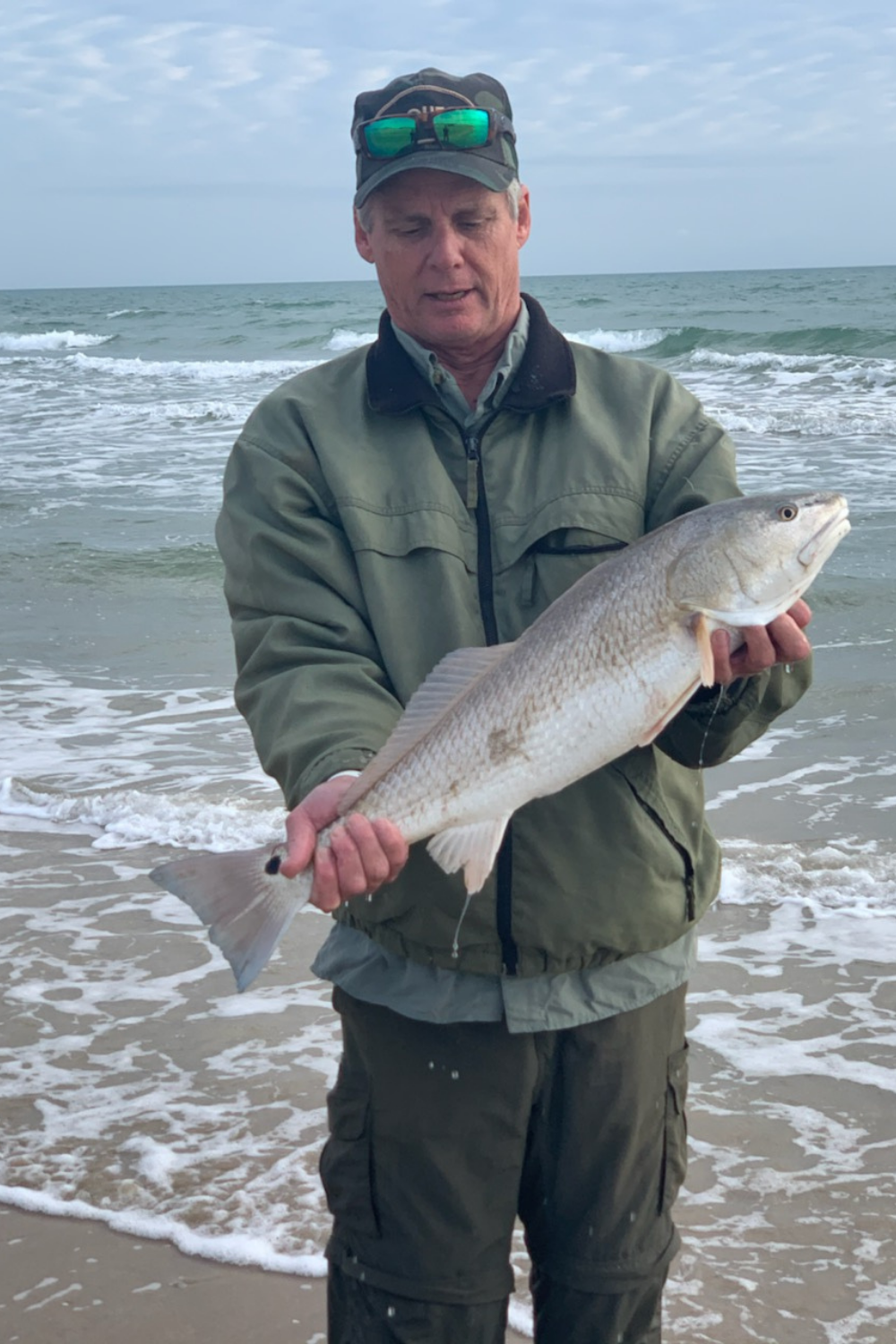
A life long surf fisherman with 50+ years of experience, I am also an avid hunter and outdoorsman. I will be sharing my passion for the outdoors with you so be prepared for hunting, fishing, camping, hiking and more. Along with gear reviews and the latest trends and innovations in the outdoor industry.
